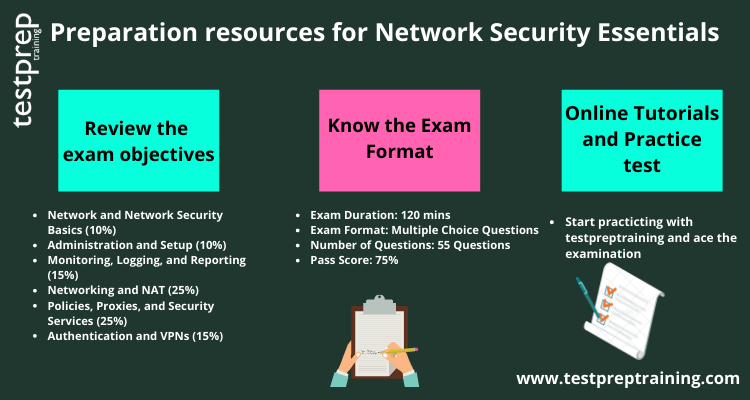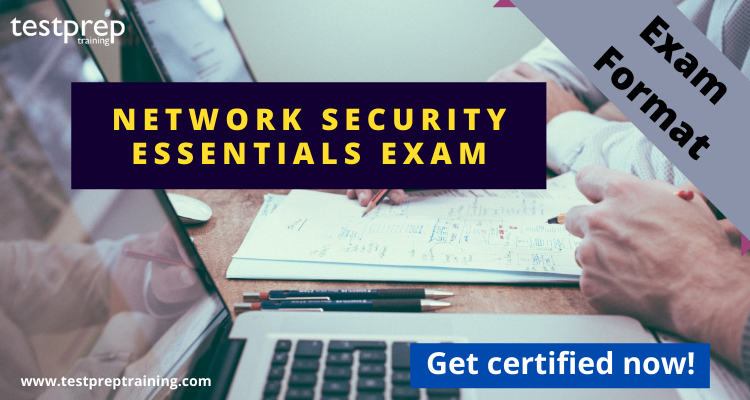The word “Network Security” refers to a wide range of technology, equipment, and procedures. In other words, it’s a system of rules and regulations designed to keep computer networks’ integrity, confidentiality, and accessibility safe. The Network security essential exam assesses your knowledge in this area. Your fundamental networking skills, as well as your ability to set up, maintain, and monitor a Watch Guard Firebox, will be considered. The test is designed for network administrators who have expertise in setting and administering Fireware V12 Firebox devices. This test will also benefit you by improving your understanding of network security.
About Network Security Essentials Exam
The Network Security Essentials exam is designed to assess a candidate’s understanding of fundamental networking as well as their ability to operate, setup, and monitor a WatchGuard Firebox. It also comes with centralized administration and network visibility features. This test is also appropriate for network administrators who are familiar with the setting and maintaining Firebox devices that run Fireware v12.4.
Key Concepts of Network Security Essentials exam
To powerfully complete the Network Security Essentials exam, the candidate must comprehend these following key concepts:
1. Fireware Knowledge
- Firebox activation and initial setup
- Network configuration
- Policy and proxy configuration
- Subscription services configuration
- User authentication
- Device monitoring, logging, and reporting
- Branch office and mobile VPN configuration
2. General Network and Security Knowledge
- IPv4 networking concepts (subnets, DNS, TCP/IP, DHCP, NAT, static routing)
- General understanding of firewalls
Exam Format
The Network Security Essentials Exam consists of 70 that need to be completed within a time span of 120 minutes. You need to manage your time accordingly. Furthermore, it advised that since there are 70 questions in total, then, you should not spend more than 1 minute 30 seconds on each question. On average, if you finish your examination in 90 minutes, you will still have 30 minutes to revise and recheck your answers.
In addition, the exam includes various question types like case studies, short answers, multiple-choice, and mark review. To manage your time effectively, start with the case study questions as they usually take the most time. Then, move on to short answers and finish with multiple-choice. Remember, you must score at least 75% to pass the exam.
Course Outline
Here we are discussing the objectives that a candidate needs to cover in order to pass the exam.
1. Network and Network Security Basics (10%)
- IPv4 addresses, subnetting and routing (WatchGuard Documentation: Use a 31-bit or 32-bit Subnet Mask, Understanding IPv4 Subnetting (Part 1), IPv4 Subnetting (Part 2))
- The Network Address Translation (WatchGuard Documentation: Network Address Translation (NAT)
- Then, packet headers (TCP, IP, HTTP) (WatchGuard Documentation: HTTP Request: Header Fields, Firebox Configuration Best Practices)
- The MAC addresses (WatchGuard Documentation: Wireless MAC Address of a Trusted Access Point)
- Network services, ports, and protocols (WatchGuard Documentation: About Ports, Firewall Settings)
2. Administration and Setup (10%)
- Firebox default policies and network settings (WatchGuard Documentation: Factory-Default Settings, Setup Wizard Default Policies, and Settings, Firebox Configuration Best Practices)
- The Fireware Web Setup Wizard (WatchGuard Documentation: Run the Web Setup Wizard)
- Feature keys (WatchGuard Documentation: About Feature Keys)
- Firebox backup and restore (WatchGuard Documentation: Firebox Backup and Restore)
- Configuration file migration (WatchGuard Documentation: Move a Configuration to a New Firebox, Firebox Upgrade, Downgrade, and Migration)
- Default threat protection (WatchGuard Documentation: About Default Threat Protection)
3. Monitoring, Logging, and Reporting (15%)
- Tools to monitor Firebox status and activity (WatchGuard Documentation: Monitor your Firebox with Fireware Web UI)
- Diagnostic tools in Firebox System Manager (WatchGuard Documentation: Run Diagnostic Tasks on Your Firebox)
- Firebox logging to Dimension or WatchGuard Cloud (WatchGuard Documentation: Enable Logging for Firebox Cloud)
- Firebox log messages (WatchGuard Documentation: View Log Messages (Dimension), Read a Log Message)
- Logging settings (WatchGuard Documentation: Set Up Logging to a WSM Log Server, Configure Logging Settings)
4. Networking and NAT (25%)
- Network interface types, security zones, and settings (WatchGuard Documentation: Network Modes and Interfaces, Configure a Custom Interface)
- WINS/DNS (WatchGuard Documentation: Configure Network DNS and WINS Servers, About DNS on the Firebox)
- Routing and static routes (WatchGuard Documentation: Routes and Routing)
- NAT types and configuration (WatchGuard Documentation: Network Address Translation (NAT), Configure Firewall 1-to-1 NAT)
- DHCP (WatchGuard Documentation: Configure an IPv4 DHCP Server)
- VLANs (WatchGuard Documentation: Define a New VLAN)
- Multi-WAN and SD-WAN actions (WatchGuard Documentation: Multi-WAN and SD-WAN)
6. Policies, Proxies, and Security Services (25%)
- Packet filter policies and proxy policies (WatchGuard Documentation: About Policies)
- Policy precedence (WatchGuard Documentation: About Policy Precedence)
- HTTP proxy (WatchGuard Documentation: About the HTTP-Proxy)
- HTTPS proxy content inspection (WatchGuard Documentation: HTTPS-Proxy: Content Inspection, HTTP Content Action, and Domain Name Rule Examples)
- Content actions and domain name rules (WatchGuard Documentation: HTTPS-Proxy: Domain Name Rules)
- Firmware subscription security services (WatchGuard Documentation: WatchGuard Security Services, About Subscription Services)
7. Authentication and VPNs (15%)
- Firstly, Authentication servers (WatchGuard Documentation: Authentication Server Types)
- Secondly, Users and groups in policies (WatchGuard Documentation: Use Users and Groups in Policies)
- Thirdly, Firebox authentication portal (WatchGuard Documentation: User Authentication Steps, Firewall Authentication)
- Fourthly, Mobile VPN routing options and protocols (WatchGuard Documentation: Select a Mobile VPN Type, Configure VPN Routes)
- Subsequently, Branch Office VPN gateways and tunnel routes (WatchGuard Documentation: Configure Manual Branch Office VPN Tunnel Switching, Add Routes for a Tunnel)
- Furthermore, Branch Office VPN and NAT (WatchGuard Documentation: Configure 1-to-1 NAT Through a Branch Office VPN Tunnel, Configure Outgoing Dynamic NAT)
- Last but not the least, The BOVPN virtual interfaces (WatchGuard Documentation: About BOVPN Virtual Interfaces, Configure a BOVPN Virtual Interface)
Preparatory Guide for Network Security Essentials Exam
The resources that can help you cover the majority of the syllabus in a shorter amount of time are the greatest, and you should use them. Simply ensure that the materials you select are appropriate for your level of comprehension and that the data is correct. Furthermore, you should start early and plan out your preparations. This study guide includes all of the materials and steps you’ll need to pass the test. Let’s talk about it!

1. Online Tutorials
Online Tutorials can help you improve your knowledge and have a better comprehension of test themes. They also go through test information and policies. These online courses, on the other hand, give in-depth information about the test. As a result, you will be more prepared for the exam. As a consequence, learning using Online Tutorials will help you improve your preparedness.
Expert Corner
When you first start studying, it’s critical to go over all of the exam objectives. Furthermore, doing so will provide you with a clear picture of all the distinct topics and abilities that you will need to master. Furthermore, examining the exam objectives can eliminate any misunderstanding in your mind, allowing you to concentrate on your preparation. Exam objectives can aid in the reinforcement of modules and subtopics. There are other books available, and you should join the community to interact with others who share your interests.
The final stage to success is to put what you’ve learned into practice. Taking a practice exam is also a terrific method to mix up your study technique and guarantee that you get the greatest scores on the real thing. Furthermore, in order to ensure comprehensive preparation, it is critical to analyze the practice exam. We give free sample papers to assist you in succeeding in the test. Furthermore, these free sample exam papers will give you a feel for a real-life exam. As a result, be ready right now!



